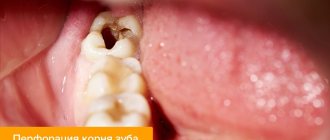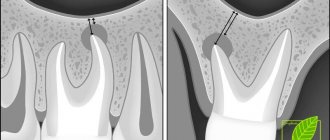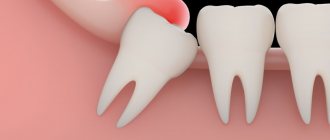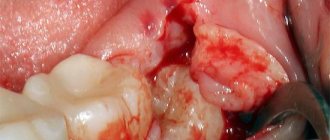If the resulting hole in the tooth is not filled in time, it may collapse and will have to be removed over time. You need to figure out why holes appear in teeth and how to deal with them.
The most basic reason for the appearance of a hole is tooth disease with caries, which first appears as a small dark spot on the tooth enamel. If caries is not treated at the initial stage of its appearance, it can gradually grow, penetrate into the tooth pulp and form a carious cavity. This cavity must be filled so as not to lose the entire tooth. A filling is placed if the tooth is affected by simple caries or complicated caries, or if pulpitis or pericementitis occurs.
Installing a seal
The task of the doctor who has discovered a tooth damaged by caries is:
- drilling out dead tooth tissue and darkened parts of enamel;
- expansion of the carious cavity;
- checking the condition of the pulp;
- preparing the tooth for filling.
The filling process consists of:
- in disinfecting the drilled cavity and drying it;
- installing a medicinal inlay into the tooth canals;
- installation of a temporary filling;
- A permanent filling is installed when a tooth is cured and the lost parts need to be restored.
Classification of carious cavities by location
Depending on the location of the pathological processes, the following types of carious holes are distinguished:
- A cervical or root hole is formed under the tooth near the gum. Accompanied by the formation of a black hole in the tooth, inflammation of the gums, bleeding of soft tissues and rapid damage to the root system.
- A contact hole in a tooth forms on the surface and is accompanied by pronounced symptoms.
- An interdental hole is formed between the teeth. Carious processes often affect a pair of crowns.
- A fissure hole in a diseased tooth is accompanied by carious lesions of the natural grooves in the chewing units (fissures).
- The circular hole is a brown band on the dental neck. It is dangerous because it threatens tooth fracture as a result of thinning of hard tissues.
What to do if there is a large hole in the tooth?
After discovering a carious hole, we recommend that you immediately consult with a dentist at the Partner-Med clinic or another experienced specialist. If, before visiting the dental office, a hole in the tooth is very painful, you can reduce the severity of the symptom using the following recommendations:
- clean the hole with a toothbrush from food debris;
- rinse your teeth with a solution of baking soda: for 1 glass of boiled warm water, 1 tsp. soda
Such manipulations will help relieve pain, relieve inflammation and alleviate the general condition.
Types of permanent fillings
- Metal seal. Advantages: long service life, inexpensive cost. Disadvantages: long hardening time, contrasting color with the color of the enamel.
- The cement filling can be phosphate or glass ionomer. Advantages: release of fluoride ions, which prevent the formation of caries. Disadvantages: fragility and short service life.
- Composite fillings are made from an epoxy mixture. Advantages: long service life. Disadvantages: long time to install the filling.
- Plastic fillings are made on the basis of acrylic acid. Advantages: high strength. Disadvantages: the formation of micropores in the filling, through which caries can penetrate.
- Ceramic inlays are used to restore a damaged tooth. Advantages: strength and reliability. Disadvantages: high cost and long installation time.
Weak and strong caries of anterior teeth
Spot
A chalky stain is a clear sign of a lack of minerals and the beginning of the destruction of the enamel structure. They are white in color and respond well to treatment at the initial stage. There may be a reaction to sweets.
Surface
At this stage, the enamel loses its integrity (which is especially noticeable upon probing), and the stain acquires a brownish tint. A painful reaction to temperature and chemical stimuli appears.
Average
The stage at which dentin is affected. A noticeable carious cavity appears on the surface of the tooth; over time, the crown part begins to change color. Severe pain occurs when eating cold and hot food and a reaction to sweets.
Deep
The most severe caries of the front teeth occurs when the deep layers of dentin are damaged. Severe pain from temperature stimuli and a pronounced aesthetic defect are observed.
What to do when your tooth already hurts?
Immediately contact a dentist who will treat the diseased tooth and, if necessary, install a filling on it.
To prevent the development of tooth pain, you must regularly undergo preventive dental examinations by a dentist, who can diagnose caries at an early stage of development and prescribe dental treatment. Untimely treatment can lead to tooth decay and loss.
The appearance of holes in teeth: causes
As such, there are many reasons for the occurrence of holes in teeth due to carious lesions; they are divided into two large categories:
- Maintaining an unhealthy lifestyle: disrupted diet and eating schedule, bad habits (smoking, systematic consumption of large quantities of alcoholic beverages, drug addiction), neglect of the rules of personal hygiene (oral care);
- Category of external causes independent of the person himself: genetic inheritance, gender characteristics, malocclusion.
Among the reasons for these two categories, the most common are:
- Individual physiological characteristics. Often, the formation of cavities in teeth is predetermined by the low quality of their enamel, sparsely set teeth, and malocclusion. If you have “gaps” between your teeth, pay attention to hygiene and be sure to use dental floss after every meal. Remove food debris that may accumulate between teeth to prevent tooth decay and resulting holes. If you have an incorrect bite, this ideally needs to be corrected, since in this case the enamel wears out much faster and the teeth become defenseless against bacteria;
- Climatic conditions of residence can also affect the frequent occurrence of this problem. Bad water, lack of nutrients in the soil - all this not only does not prevent, but even contributes to the appearance of caries in residents of these areas;
- Poor nutrition. If a person actively consumes high-carbohydrate foods, the occurrence of cavities cannot be avoided. Nutrition must be systematized and brought to a stable schedule.
It is worth noting the fact that most often, holes in the teeth appear in women, especially during breastfeeding and pregnancy.
Naturally, it does not happen that a person went to bed in the evening with a completely intact tooth, and woke up the next morning to find a hole in it. The process of cavity formation is gradual:
- Initial stage. The enamel becomes dark; it is important not to skip this stage, since by taking measures (by seeking professional cleaning from a dentist) you can avoid the occurrence of caries. Often, the dentist prescribes the use of a specialized medicated tooth powder, which is used to treat caries much more effectively than toothpastes;
- Stage of superficial damage. The damage extends to the top layer of the tooth. This stage is accompanied by increased sensitivity of the tooth when eating food that is too hot or too cold; there is no painful sensation as such;
- Middle stage. The damage spreads to the dentin, a microscopic hole appears, which can cause the first noticeable discomfort in the form of unpleasant sensations during eating;
- Final stage. The hole becomes noticeable, pain appears, and blood vessels and nerves may be affected. This stage may be accompanied by pulpitis.
When there is black caries, but it is still not treated
Many people have encountered a situation where a doctor, during an examination, confirmed the presence of the initial stage of caries, but refused to treat it according to the standard regimen. Why is this happening? The thing is that during drilling of dentin, much more hard tissue is damaged than it seems at first glance. But it is impossible to install a seal without drilling.
Trying to avoid unnecessary destruction of the crown, the doctor does not want to drill into black caries at the spot stage. Very often its dimensions do not change at all for a long time. The spot itself does not cause a person any discomfort. If you brush your teeth thoroughly after each meal, use high-quality toothpaste and remineralizing dental gel, you can maintain caries at its original size for several years, that is, avoid its increase.
Therefore, if the dentist says that there is no need to touch the tooth yet, you should listen to his words. This is a way to preserve hard tissues without changing their volume for the coming years.
Complications from the hole
It has been said that caries is the starting point for the formation of a hole. If it is not treated in time, pulpitis will begin, then the disease will develop into periodontitis. Pulpitis and periodontitis are often treated using surgical methods.
A feature of pulpitis is that the pulp chamber is opened. The person begins to suffer from severe pain. In this case, the occurrence of pain does not depend on irritating factors. The pain wears him down the most at night. Pulpitis can exist in two forms: acute and chronic. If this disease is not treated, it will develop into periodontitis.
With this disease, an abscess forms. If suppuration affects the underlying tissue, osteomyelitis will occur. If a lesion containing pus breaks through, blood poisoning may occur.
When black caries still needs to be filled?
You need to clean a black spot using a drill if:
- the patient complains of increased sensitivity to sour, salty and sweet foods, temperature changes;
- when there is mechanical impact on the damaged crown, pain occurs;
- the hole is growing in size too quickly;
- the speck is located in the area of the neck of the tooth;
- there was an unpleasant odor from the mouth;
- The black defect is localized on the incisors and spoils the smile.
In all these cases, the fight against carious lesions is carried out according to the classical scheme. The patient is injected with an anesthetic, after which the carious lesion is cleaned from altered tissues using a drill. The cleaned area is treated with an antiseptic and filled with a filling solution. The latter is dried with a lamp and then sanded to achieve the correct shape and perfect smoothness. As a result, the unit begins to look aesthetically pleasing, and its service life increases significantly.
Home methods
It is possible to cope with caries using folk remedies only when the pathological process is at the stage of a chalky spot. So, special medicinal pastes with fluoride and calcium (they should be selected by a dentist) help to temporarily seal and stop the spread of the anomaly. In addition, it is necessary to normalize the regime, balance the diet - introduce into the daily menu as many foods as possible with a high content of calcium, potassium, fluorine and other useful substances.
Japanese scientists have developed a toothpaste that “seals” holes in enamel
Important! Daily thorough brushing of teeth, gums, and tongue is an important measure for the prevention of caries.
How to quickly relieve pain in a carious tooth at home:
- close the hole with a piece of lard, beets, propolis;
- massage the ear on the sore side;
- rinse your mouth with a decoction of chamomile, calendula, and yarrow.
Prevention of caries
The easiest way to avoid fillings or minimize the number of fillings is to visit your dentist regularly. This should be done at least once every six months. Simple tips will also help keep your teeth healthy:
- Careful hygiene. You need to brush your teeth with a high-quality brush and toothpaste at least twice a day.
- Using dental floss will help remove plaque from hard-to-reach places.
- Rinsing with special liquids will also help keep your gums healthy, which play a huge role in keeping your mouth healthy.
- A balanced diet will help ensure you have enough vitamins and minerals to keep your teeth strong.
Now we treat teeth even better!
Treatment, re-treatment of canals, elimination of caries under a microscope without damaging healthy tooth tissue.
We do everything to save your own tooth. Consultation with specialists is FREE!
More details
Online consultation with a doctor about possible complications of self-medication
If your permanent or temporary filling has fallen out, or a piece of a tooth has broken off, you should not waste time or try to cover the defect yourself with something. It is best to undergo an examination and consultation with a dentist. Because no available means can replace a dental filling or perform proper sanitation. A professional assessment of the condition of the tooth is necessary. Otherwise, complications may occur, infection of the wounded area, and inflammation of the nerve. Which will lead to more complex and expensive treatment:
- treatment of pulpitis;
- restoration with inlay;
- removal of a tooth;
- dental implantation;
- prosthetics.
Dental roots affected by caries are a dangerous source of infection in the body.
When the carious process has destroyed not only the crown, but also the roots of the tooth, it is necessary to part with them as quickly as possible. Removing the root of a decayed tooth cannot be called a simple surgical procedure, but modern anesthetics and professional skills allow the doctor to carry it out quickly and without significant pain. If this is not done, rotting roots will create a serious health problem for the patient.
- Pathogenic microflora will spread to neighboring teeth.
- There will be a persistent unpleasant odor from the mouth.
- A cyst or granuloma may form around the root tip. Pus from the overgrown local formation will sooner or later release into the gum tissue - a flux will form, which will already capture the entire upper or lower jaw and “swell” the cheek.
- A persistent focus of infection will cause a significant decrease in immunity.
When treating gumboil, the patient's gums are first cut under anesthesia to allow the drainage of pus and to disinfect the source of infection. Without this manipulation, it is impossible to remove the tooth root, since it is impossible to inject an anesthetic into the gum tissue filled with pus. When sending a patient home, the dentist cannot even be sure that he will return to remove the root. Unfortunately, many avoid surgical intervention, which means they will soon face a relapse of the disease.
Caries between the front teeth, at the root and on the cutting surface
Caries between front teeth
Interdental caries of the anterior teeth is considered one of the most common. It, as the name suggests, affects the area between the teeth. In this place, the enamel is thinnest, and due to food debris, there is a high concentration of bacteria. Tooth decay on the lower front teeth is usually less common.
Root caries of anterior teeth
It is localized in the area of the neck of the tooth, hence the name. The lesion usually begins with a yellowish spot, which later turns brown. In the later stages, the disease significantly destroys tissue, so treatment of cervical caries of the anterior teeth must be timely.
Contact
Most often occurs in children during the formation of baby teeth. In adults, this type of lesion occurs due to a genetic predisposition or a lack of minerals and other necessary components for the health of the enamel. Contact caries of the anterior teeth can appear when the process on the diseased tooth affects the neighboring one and “infects” it.
Symptoms
At the initial stage of caries development, the color of the enamel on the chewing or front tooth changes. The surface of the affected unit becomes rough, heterogeneous, and covered with chalky spots. There is no pain, only a cosmetic defect of the tooth is visually noticeable. To cope with this problem, you do not need to drill a tooth; it is enough to use only applications with medicinal compounds or use an innovative toothpaste that closes holes.
As a rule, patients are shown formulations with fluorides, calcium compounds and other substances to remineralize enamel. Superficial caries is a clearly defined area on the enamel of a round, oval shape, and does not differ in color from healthy tissues. In most cases, there is no pain; some patients note increased tooth sensitivity to hot, cold, and sour foods.
Important! The manifestations of superficial caries can be removed by preparation followed by filling.
With medium-depth caries, all layers of enamel are destroyed, which are localized down to the enamel-dentin border, the surface layer of dentin. The tooth hole deepens, is clearly visible to the naked eye, and food particles begin to get stuck in it. This form of the pathological process is eliminated by filling.
Deep caries is accompanied by the formation of large band defects affecting both enamel and dentin. There is pain in the affected tooth, the patient faces difficulties and discomfort during chewing food and hygiene procedures. The tooth reacts sensitively to the action of any external irritants - as soon as contact with them ceases, the unpleasant sensations immediately disappear.
The initial stage of caries “makes itself known” with chalky spots on the enamel
What does a dentist do to remove deep caries:
- places an application with medicinal paste into the hole to restore the dentin structure and relieve irritation from the pulp;
- installs an insulating gasket;
- seals the affected unit.











